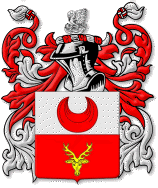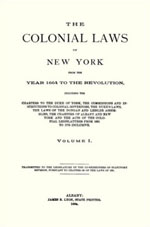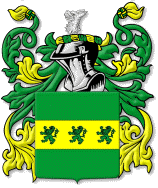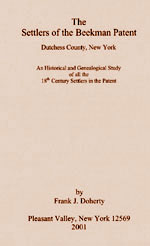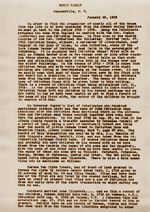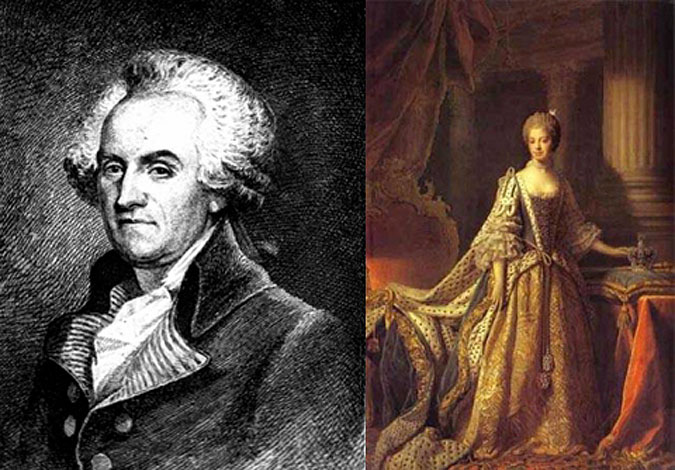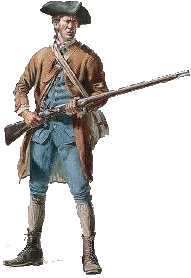 |
"John
Hause, born 1690, lived in New York until his marriage in 1715 to Sarah Allen,
a woman of fine English Blood. After his marriage, he removed to Haverstraw, Rockland
Co., New York."
—From the Genealogy of John Hause Descendants, compiled by Alfred B. Hause in 1904. Source: Family Bible of Joseph Hause of Ovid, New York, mid-1800's.
|
Our genealogy, according to transcriptions from our oldest Hause Family Bible, states that John I (actually John II, if we're talking about the "John" born in 1690) was a cousin to Queen Mary II of England, who ruled jointly with William III from 1689 to 1694. The story goes that Queen Mary II sent John to America to avoid religious persecution. So as you can see, I'm not the first writer in my family to create fiction.¹
This has led many family genealogists to conclude that JOHANNES HAUS, son of JOHANN CHRISTIAN HAUß, was the John Hause who was born around 1690 in Großaltenstädten (one source has the date as June 27, 1688), and traveled to the New World with his father, his sister Anna Elizabeth, and his brothers Rheinhardt, George, Conrad, Harmonius, and possibly another named Elias.
Although this family Bible claimed that Johannes and his family were "cousins" to the Stuarts, they would have been very distant cousins, at best. First off, no genealogies are more researched and picked-over than Royal genealogies, and no genealogist has ever recorded a Hauss as being related to a Royal family. The only name coming close to ours in the Stuarts' official Palatine family line is "Van Hessen," but that family's connection to us is doubtful. Our family was poor, and they were sent to a harsh Colonial frontier—hardly the place a queen would send her infant cousin. Nor would she make her cousin an indentured servant, who would have to work for years just to reach the poverty level! So the most likely reason that Johannes was called a "cousin" to Queen Mary in the family history is because she was cousin to the Dukes of Solms, through her marriage to William III of Orange (the grandson of Amalia of Solms-Braunfels).
According to
these same family histories, Johannes married SARAH
ALLEN, "a woman of fine English blood," from a prominent family in
Haverstraw, in the year 1715. (Apparently Johannes spoke English well enough to marry into
a British family—hmm...maybe there is something to the Queen Mary story...) But even being of "fine English blood" didn't help a woman much back then. Colonial America was a hierarchical society in which women were totally subordinate to men. They were not expected to run businesses or to follow professions. They could not vote or hold public office or sit on a jury. They were, for the most part, denied education beyond the skills they would need in their own households. Married women could not own property in their own names. So even though Johannes was just a poor Palatine refugee as opposed to Sarah, descended from British nobility, Johannes was still the boss of the family.
 "New and Exact Map of the Dominions of the King of Great Britain on ye Continent of North America, containing New Foundland, New Scotland, New England, New York, New Jersey, Pensilvania, Maryland, Virginia and Carolina, according to the Newest and most Exact Observations By Herman Moll, Geographer," created in 1715. (Click here to enlarge.) |
|
|||||||||||||||||||||||||||||||||||
Johannes and his family then moved closer to his brother Rheinhardt in southeastern New York State: North of the New Jersey-New York border, west of the Hudson River, and northwest of New York City. Johannes ended up in a veritable wilderness called Haverstraw.
Henry Hudson is credited as the first European to set eyes on this land. In 1609, Hudson, under commission to the Dutch East India Company, sailed up the river which would one day bear his name. He anchored in the widest point in the river, off what is now known as Haverstraw. He mistakenly assumed that he had found the legendary "Northwest Passage" to India, and he continued his voyage upstream to Albany before he realized his mistake and headed for home.
Early attempts to settle the county by the Dutch were generally unsuccessful, and in 1664 they handed the territory over to the English. In 1686, the Duke of York, later to become King James II of England, established the county system and designated the area as "Orange County." The precinct of Haverstraw was established there in 1719. There had been just 439 inhabitants living in in the area in 1712, but under British rule the population increased dramatically to 1,969 by 1731. Whether Johannes was a carpenter, farmer or miller—the three strongest trades in the area—is unknown (although you had to be proficient at all three to survive a winter in that area).
 |
The history of Haverstraw at this point in time is mostly speculative. Fewer than 700 people lived there before 1730, and travel was largely confined to Indian trails by land and sloops by the Hudson River. The Ramapo Mountains were hard to cross, and it would be many years before adequate roads could be built. But considering that Johannes was raised in the Rhine region of the Palatinate, he was probably better prepared than most to work in that environment. Beyond that, Haverstraw became the preeminent manufacturing town for bricks in all of the United States by the 19th Century, to the point where the entire town collapsed and sank in the early 1900's because so much clay had been removed from the soil. With that, many early buildings and early historical documents were lost.
Johannes and Sarah lived a few miles from Sleepy Hollow, which was later the locale of Washington Irving's tale of Ichabod Crane and the Headless Horseman. (If you read in the "Allen" family history, you will see that descendants of Sarah's family were possibly the inspiration for the story's characters of Brom Bones—the villain—and the girl he and Ichabod Crane were fighting over, named Katerina.)
Johannes and Sarah raised six children, which was actually a small amount of kids for a woman to have at the time. This was because at the time of the Hauss family's arrival, men outnumbered women 6 to 1 in some American colonies. With so few women and so many men, almost all of the women married very early. Early marriage extended the years in which women could bear children, and so she could expect to bear an average of eight. So Sarah got off relatively light:
CHILDREN OF JOHANNES HAUS AND SARAH ALLEN |
Very few records of Haverstraw from this time exist (a fire wiped out most of them in the mid-nineteenth Century)... and Johannes then seems to disappear from the record, entirely. (Not that there was much in the record of Johannes before this time, either.) It's even impossible to find records of the children! So all that we really know is what family legends tell us: that he lived on the edge of the New York frontier, and that he was the last in our line to be born in 'The Old Country'...
...Or so we think...
 |
|
He was born by some family accounts in 1719 (or 1726, but we'll get to that later). He was probably delivered at his parents' home, with the assistance of a midwife. In early colonial culture, children were sort of on their own for the first few years. Parents at that time loved their children but didn't get too close, because of the high mortality rate. The hard fact was that people on the frontier knew there was a great chance that their children would die. Most didn't make it to the age of eleven.
According to the customs of the day, John probably wore a dress through most of his infancy, and a "puddinghead cap" to protect his cranium until it hardened. He was raised in the unisex fashion of the time, and not considered a "man," until he was about six. Then he was old enough to be "breeched"—his dress was taken away, his long hair was shaved, and he was given his long pants—officially becoming part of the family labor force.
He probably had very little schooling. Just enough to learn a trade between chores on the farm, and basic math so he wouldn't get taken buy peddlers or customers. But most of his teens would've been spent working in the field.
Sometime in the 1740's (usually charted as 1744, but listed by some in his daughter Anna Margaretha's line as 1739 in Linlithgo, Columbia County) John married SARAH WHEELER (or WEILER), from a prominent local family based in Kinderhook, Columbia County.
Many German customs were still in effect during courtship at this time. The oddest of these was probably "bundling." In this ritual, courting couples were allowed to spend the night together in bed, fully dressed. It is unknown today if there was a chaperone or a "bundling board" to separate the couple, but the practice became controversial and finally eliminated in the 1750's. We do know that by the time of John and Sarah's union, about 30% of children born in the colonies were delivered less than eight months into the marriage, so either the boards were too low or the chaperones were sleeping!
After the formal engagement of John and Sarah came the "posting of publication of the banns" a fortnight before the wedding, so that any person with reason to object to the marriage could do so. (We have no record of this ritual for John and Sarah, but we know her family, in particular her grandfather, Everett, practiced it.) Marriage was not conducted with the bride and groom in special gowns, but in the best clothes they already owned.
|
THE LAWS OF COLONIAL NEW YORK: |
|
|
As John descended from a carpenter, he probably had a nice home with a bed and bedstead—the most expensive possessions of the era. You needed a strong bed, because in many Colonial homes the children also slept in the bed—alongside their sexually active parents! Privacy was not an option in the wilds of Colonial America. At least the mother and father kept their clothes on, as Northern Europeans usually wore their shirts and shifts during sex. (A person wearing a shift was described as "naked," while actual nudity was described as "from nature." Generally, people were only "from nature" when they were getting flogged by officials in the village square, not in the bedroom.)
We know that John and Sarah eventually moved from Haverstraw to the town of Warwick, but tracing their movements is hard. A "John Hanse" is listed in the earliest records of Monroe, the Southeast-most town in Orange County near the Ramapo River, along with members of the Conklin family (John's sister Sally married Amos Conklin). "Hanse" seems to be a common misreading of our surname in early records, but whether this would be Johannes or John III, if either, is hard to say.
John and Sarah lived long, productive lives, with extensive family and friends. The records of their lives are numerous in the church records of the time—you just have to be patient and check EVERY spelling variation. (In those days with few schools and no formalized language, the spelling of names was usually done phonetically, so John's last name often changed from Haus to Haas to Haws to Hauss to Howes to Huus to Huis to Hous to House to Hause—for the christening of his daughter Marritje in 1750, John III's name was even listed as "Johamnes Huyser"). Here's a listing of all their known children:
CHILDREN OF JOHANNES HAUS AND SARAH WHEELER |
| |||||||||||||||||||||||||||||||||||
There doesn't seem to have been a consistent church or parish that the Haus family attended, but that was common in Colonial America. By the mid-1700's, fewer than 20% of the population was linked to a specific church or religion (10% in New York City), and most of the church members were women. The congregation of a church was not there to enforce strict religious doctrines—they were there to provide a focus for family life in the community, and to help settlers make connections and survive in the wilderness of the New World.
The Haus family seemed to attend German (Dutch) Reformed and Lutheran churches, but that could just be because they were the most common in German immigrant communities, and settlers went to whatever church was available to them. German Reformed congregations were similar enough to the established Dutch Reformed religion that they accepted the Dutch Reformed Classis of Amsterdam as their ecclesiastical superior. The Classis provided spiritual guidance, and certified ministers as orthodox. But by 1741, there were fifty-one German Reformed congregations in the Mid-Atlantic Colonies, and only four competent ordained ministers to care for the region's 15,000 German Reformed settlers. So in rural areas like the Haus family lived in, the churches were usually became "pietistic," and threw away doctrinal exactness in church. The clerical education of the preacher meant nothing. Communion was limited to those who made a full confession, and the worship was spontaneous and ecstatic. This emphasis on personal religious experience over theological dogma or liturgy won over many small independent sects and unchurched families in German areas, and forty-nine more congregations developed by 1750, during the period of "The Great Awakening."
John and Sarah sponsored many of the children of their neighbors and friends in baptisms at these local churches. (Their family seems to have been strongly allied with the Wheelers—for obvious reasons—and the Klapper family, who married at least two of their children.) Here are some baptisms in which John III and Sarah Wheeler were the sponsors:
| Baptism
Date: 08 Jun 1766 Father: John Decker Robinson Mother: Lisabeth Haus (ELISABETH #1) Item #: 338 Child: John Sponsor: Johannes Haus; Sara Haus Baptism Records of the Gallatin Reformed Church: Gallatinville Gallatin Reformed Church 1748-1899 | Baptism
Date: - 1769 Father: Conrad Klapper Mother: Maria (John and Sarah's daughter) Item #: 268 Child: Johannes Sponsor: Johannes Haus; Seri Birth Date: 18 Apr 1769 Baptism Record of St. Thomas Lutheran Church: Churchtown, Columbia County St. Thomas Lutheran Church 1760-1899 |
| Baptism
Date: - 1773 Father: Conrad Klapper Mother: Maria Item #: 372 Child: Sara Sponsor: Johannes Haus; Sara Birth Date: 28 Feb 1773 Page: 18 Baptism Record of St. Thomas Lutheran Church: Churchtown, Columbia County St. Thomas Lutheran Church 1760-1899 | Baptism
Date: - 1767 Father: Wilem Tailor Mother: Annatge Item #: 9 Child: Seri Sponsor: Johannes Haus, & wife Seri Birth Date: 21 Jan 1767 Baptismal Record of St. John's Evangelical Lutheran Church: Manorton St. John's Evangelical Lutheran Church 1765 - 1872 (Lutheran Church of Livingston) |
| Baptism
Date: - 1769 Father: Niclas Wiehler (SARAH'S BROTHER) Mother: Maria Item #: 44 Sponsor: Hanes Haus; Sara Birth Date: 07 Mar 1769 Page: 3 Baptismal Record of St. John's Evangelical Lutheran Church: Manorton St. John's Evangelical Lutheran Church 1765 - 1872 (Lutheran Church of Livingston) |
Baptism Date: 17 Oct 1779 Father: Peter Clopper Mother: Grietje Howes Item #: 1375 Child: Sarah Sponsor: Johannes Howes; Sarah Howes Birth Date: 29 Sep 1779 Comments: (baptisms #1370-1378 performed at Magare Vlahten) Baptism Record Linlithgo Reformed Church: Livingston Linlithgo Reformed Church 1722-1889 |
| Baptism
Date: 11 Oct 1781 Father: Johannes Huis Mother: Christina Whitbeek Item #: 1554 Child: Sarah Sponsor: Joh's Huis; Sarah Huis Birth Date: 13 Sep 1781 Comments: (baptisms #1547-1561 performed at Taconick) Baptism Record Linlithgo Reformed Church: Livingston Linlithgo Reformed Church 1722-1889 | Baptism
Date: 20 Oct 1782 Father: Peter Clopper Mother: Christina Huis Item #: 1690 Child: Johanes Sponsor: Johanis House; Sarah House Birth Date: 11 Sep 1782 Baptism Record Linlithgo Reformed Church: Livingston Linlithgo Reformed Church 1722-1889 |
|
|||||||||||||||||||||||||||||||||||
In fact, when you look at who sponsored the various children of Johannes III and Sarah Wheeler and the various families allied with them, you have to ask, "where are Johannes II and Sarah Allen?" In fact, there's no record of them anywhere! They never appear on Hunter subsistence records, and the government was careful about those records, because they expected repayment per head for all expenses Johann and his family incurred. If there was another son as old as Rheinhardt (about 20 at the time of the voyage to America), he should have been on that list.
More than one genealogist believes that the father of John III actually is Rheinhardt, not Johannes Jr.: Historian Henry Jones, in his landmark, award-winning work, The Palantine Families of New York, lists the John who married Sarah Wheeler as one of Rheinhardt's children. (He isn't encumbered by 300 years of tradition in a family bible!) The lack of historical evidence for our Bible story is striking: There's plenty of evidence of the existence of Johann and Rheinhardt on the Hunter lists, but none of Johann II. There's no marriage record with Sarah Allen, no deeds, no church baptisms... No record whatsoever. There's a "Johannus Hausz" naturalized on 27 Jul 1721, but he's just as likely to be the "Johannes Hose" who married Annetje Crose in 1721 in the New York City (Source: The New York Genealogical and Biographical Record, 1882; Publisher: New York Genealogical and Biographical Society. New York, NY, page 21). If "John Hause" of Germany really did exist, it's starting to look like he came to America at a different time (or—gulp—he doesn't even belong in this line).
Rheinhardt and his wife were devout Lutherans. They attended services in Hackensack, but also sponsored children in Philippsburg, and would take their children to the church in New York City for baptisms—and seaching the files of the Lutheran Church of New York City, we find the baptism of 9 week-old "Johannes Haus,"on the 29th of May in 1726... to Reinhard Hauss and his wife, Anna Elizabeth! Here's a listing of their children:
CHILDREN OF RHEINHARDT AND ANNA ELISABETH HAUS |
|
|
|
|
|
|
|
|
|
|
|
|
|
|
|
|
|
|
|
||||||||||||||||||||||||||||||||
Well, it has to be remembered that the mortality rate in Colonial times was incredibly high. Forty-five years was considered a long life, back then. By the time that Johannes Haus and Sarah Wheeler had children, Johannes I and Sarah Allen would've been in their fifties (They would have been about eighty when the last Elisabeth Hause was born, in 1769). It was very common at the time for relatives to carry on the work of raising and educating the children at the request of the deceased, so it actually would have been natural for Rheinhardt to step in as the head of Johannes' family.
However, there is another possibility. After Hunter's pine tar project was halted on September of 1712, and government subsistence had ceased, Rheinhardt took his wife, Anna Elisabeth their one child to New Jersey, settling at Hackensack. The "Simmendinger Register" lists Rheinhardt as living near the children of his stepmother, the Beckers—but get this: Simmendinger calls him "Hans Rheinhard Husz!" And Hans is a derivative of Johann! So now we have a contemporary from the Palatinate and New York calling Rheinhardt a variation of Johann (John)! Could Johann Rheinhardt and Johannes actually be the same man?
Rheinhardt's church even records him as "Johann Rheinhardt" on occassion (see churchlists in the Holland Society book, above: "1719, May 17, at N. Y., b. Apr. 24, at Philippsburg ... b. Sept. 25, 1718, at Philipsburg, Johan Reinhard, child of Urbanus Hents and wife Maria Applonia. Witnesses: Johann Reinhard Haus and wife Anna Elisabeth"). Is this all just a case of mistaken identity? Or just a case of two brothers living close to each other?
The confusion lies in the missing records destroyed in Haverstraw, but also in the fact that a hundred and fifty years had passed between the time that Johann Christian Hauß came to America and when the first written account of our family appeared. Up until then, the story had been handed down orally, as a bedtime story, and could have changed over the generations. (Moreover, the Bible account itself is a recollection from somebody who had seen it in 1900.)
What does this mean? These documents raise interesting questions, and any number of scenarios. It's entirely feasible that...
|
EITHER:
| OR:
|
Personally, I'm not prepared to say the family bibles are wrong. There really are Secord and Conklin families in the area, and they supposedly allied with the Johannes Haus family through marriage (although I can't find any records of those marriages, either). Our next ancestor, William, even fought alongside their descendants in the Revolution. But answering these questions is going to take a little more research, a few new discoveries, and a lot of luck to solve. (See "False Leads and Myths.")
Anyway, because of family interactions: their descendants being neighbors and baptism sponsors and comrades fighting in the same "Dutch" divisions of the Continental army, we can be sure we're connected to a son of Johann Christian Hauß. I'd love to tell you which son—but I can't with any certainty. Still, does it really matter? We can argue about the lineage all day. Whether John III's dad is actually Johannes or Johannes Rheinhardt, it still proves our lineage to past generations. And it leads us to the next link in our heritage...
 "A New Map of North America, from the Latest Discoveries, 1763." (Click here to enlarge.) |
|
||||||||||||||||||||||||||||||
But many colonists felt they needed protection from the British government, as well. After the war, the British Empire controlled all of North America from the East Coast to the Mississippi River, and from Canada down to Florida (which was owned by Spain). But the cost of the war had been immense, and the British Treasury was nearly bankrupt, while the national debt had doubled. Parliament decided that the people of the colonies, now safe from the French, needed to pay off more of the debt, and began creating and raising new taxes, such as the "Stamp Act" in 1865. Soon the colonists began to tire of all of the new tariffs imposed on shipments of goods and supplies, paid to a king who they never saw, who underpaid them for raw materials for British factories (the King made sure that the colonists couldn't create finished products, in order to preserve their economic servitude). But the Palatines kept to themselves, spoke mainly in their native tongues (especially in Church), and stayed out of the national and international debate raging in more populated parts of the Colonies.
"Why should the Palatine Boors be suffered to swarm into our Settlements, and by herding together establish their Language and Manners to the Exclusion of ours? Why should Pennsylvania, founded by the English, become a Colony of Aliens, who will shortly be so numerous as to Germanize us instead of our Anglifying them, and will never adopt our Language or Customs, any more than they can acquire our Complexion?"
—Benjamin Franklin
|
|||||||||||||||||||||||||||||||||
As for John Haus III, he was leasing farmland in New Jersey. According to The Minutes of the Board of Proprietors of the Eastern Division of New Jersey from 1725 to 1744, by Perth Amboy, on 18 August 1756 a lease for land at Romopock was executed (No. 184 of the Ramapo Tract) to "John Hase" which consisted of 109 acres at 12 s 6 per ann. for 3 years "from 24th March last" (Vol. III, p. 306). Then on 19 August 1763, the Board executed another lease at Romopock to "John Hawse," lot no. 171, consisting of 91 acres at 20 s, starting back on 11 August 1763 (Vol. III, p. 404, chart).
But in the next ten years, he moved up to the the state's border with New York. The 1775 Assessment Roll of Orange County lists "John Hawes" living in District five in Warwick (comprising the territory in the vicinity of Wickham's Pond, including Bellvale Valley).³ Warwick is on the west side of the Hudson, fifty-four miles north of New York City. It's the heart of the "Black Dirt Region," known for two highly prized products sticking out of the dirt: Onions and mastodons. The wide flat valleys were once a glacial lake, which became a swamp and later dried, leaving its rich black dirt. Decomposition was slow under the muck without oxygen, so mastodon bones can still be easily found. Farmers found the rich organic soil was perfect for onions (the region still grows an amazing 25% of the nation's onions).
This section of Orange County was on the border of New York and New Jersey, where German immigrants formed farming communities and pretty much kept to themselves. That is, until a key religious controversy in the Reformed Church eventually stoked the fires of revolution.
The Dutch who had settled the area had been compassionate towards the poorer Palatines, and many German Reformed churches became part of the Dutch Reformed Church, which meant they could appeal to the Classis of Amsterdam (Holland) for ministers and money to run the churches. The new German and Polish congregations were therefore known as the "Jersey Dutch." Then a period of tremendous religious and emotional upheaval, known as the "Great Awakening," swept through the British colonies in the 1730s, and those churches began to challenge the authority of Europe.
Their main gripe was the lack of authority within the American churches to ordain and educate ministers. With the proliferation of churches resulting from the Great Awakening revivals, there was a severe shortage of ordained holy men to preach the gospel (which is why you see the Haus family attending different churches, travelling to wherever their minister was preaching at that Sunday). There were only twenty Reformed ministers preaching in the American Colonies during the 1740s.
The problem was that anybody who aspired to the pulpit at that time was required to embark on a long, arduous, expensive, and often dangerous journey to Amsterdam for training and ordination. So there needed to be some kind of assembly with at least limited powers to educate and ordain ministers for the pulpit. Finally in 1747, the Classis of Amsterdam reluctantly gave its approval for the formation of such a body, which was called a Coetus.
However, the more conservative ministers in New York and New Jersey opposed this separation, feeling the church was losing touch with Old World tradition and God. Equally alarming to these ministers was the thought that a local classis could intrude into their own affairs much more efficiently than one which governed from Amsterdam. Therefore, they contested any attempt to break formal ties with foreign authority, and organized themselves into the rival Conferentie party.
|
On November 10, 1766, William Franklin, Provincial Governor of New Jersey (and the illegitimate son of Benjamin Franklin), granted a charter for Queen's College, named in honor of Charlotte, the Queen Consort. The school (which eventually became Rutgers) was established to train Dutch Reformed clergy, giving more control to the Coetus.
Severe opposition to the formation of an American classis came from established Conferentie members. But the majority of Reformed parishoners opposed the Conferentie, feeling the movement was overzealous and reactionary, and sided with the Coetus party. These two opposing forces broke apart congregations, friendships and even families. Brothers in neighboring houses refused to look at or talk to each other on the street when leaving for rival churches on a Sunday. One faction would lock out the other from worship and attacks on members of opposing factions were common. Add to these problems a lack of church leadership, because by 1771, only forty-one ministers were available for one hundred churches, leaving the most outspoken and extreme in the congregations to take charge. And because of this, it started to get political.
Because the Conferentie rejected anything new and outside of tradition and wanted to keep European ties, they sided with the Loyalist British (or Tories), while the more liberal Coetus sided with the Patriots (or Whigs). The quiet, apolitical German population that had kept to itself was now taking sides in talk of a revolution.
The infighting would become brutal and bloody. Formal armies were barely needed, as the citizens themselves began committing attrocities against each other. In 1774, the courthouse at the county seat in Tappan, Orange County, burned to the ground. The locals all suspected that it was the work of Tories, directed at deputy sherrif Ebenezer Wood. In response, militia campanies were formed, and Tories were exposed. Houses would then be burned, friends and relatives would be betrayed, and many lives would soon be lost.
As part of the first native generation of Americans descended from the Palatines, John Hause felt no real allegiance to Germany or England, and resented the ever-increasing taxes he paid on food and necessities to a ruler across the Atlantic Ocean that he had never even seen—and a government he had no voice in, and did little to protect him on the frontier. He and many others in the Haus family felt it was time for a change. But instead of moving to a different land to escape an oppressive ruler—like their forefathers did—this time the family decided to keep the land and change the ruler. They no longer
wanted an elector palatine or a Stuart to protect them. They wanted freedom. That
is the most important thing to know about this particular John (or Johannes) Hause—and
that he, and the men and women that he spawned in turn, would help to settle this
country, formulate its dreams and ideals, and make it free. Which takes us to
our next chapter, maybe the proudest chapter in our family history:
|
CHAPTER FIVE: THE REVOLUTIONARY WAR, 1775 - 1783. The Haus family is ripped apart by wartime allegiances. Johann's Loyalist Great-Grandsons attack his Patriot Grandson's village. Brother fights brother. Cousin kills cousin. Grandson's son marries Great-Grandson's daughter. Holiday family get-togethers would never be the same! PLUS: William, Revolutionary War hero, of Hause Hill.
TOP ILLUSTRATION: "Little Falls on the Mohawk," by an unknown artist. Bottom Illustration: Haverstraw, New York.
¹—An interesting theory concerning the "cousin" story was proposed by Charles Hause, in a letter now in possession of Bob and Shirley Hause of Kansas. It claims that Princess Amelia of Solm raised her orphaned grandson, William III, Prince of Orange, after he lost his mother at age ten; William then married Mary Stuart, the eventual Queen of England. As the Hauss family came from Solm, they played up the English connection in their family history. (Which would help explain the "cousin" reference to England's Queen in our family legend.)
²—William's birthdate changes from 1750 to 1751 because Britain and its colonies changed from the old style (Julian) calendar to the new style (Gregorian) calendar on January 1, 1752. But this change had occurred in Holland about 170 years earlier, in 1582, and the Gregorian calendar therefore was used in the Dutch colony of New Netherland (New York). The colony of New Netherland operated according to the laws and customs of the Netherlands province of Holland, where the new calendar had been in use since Pope Gregory introduced it in 1582. Therefore New Netherland records are dated as we would date them today, with the year beginning January 1 and no double-dating.But under the old calendar in use prior to 1752 in Britain and its colonies, the year began on March 25, and March was the first month, February the twelfth. Dates in January, February, and the first 24 days of March were often "double-dated" to indicate both the past and incoming years. For example, what we would call February 24,1714 would then have been February 24, 1713, but could also be written February 24,1713/14. It would also have been the 24th of the twelfth month, not the second month.
When the new calendar was adopted, eleven days had to be dropped, and this was done by declaring that the day after September 2,1752 was September 14, 1752.
After the English conquered New Netherland in 1664, and except for the brief return of Dutch rule in 1673-74, the old (Julian) calendar was used in official documents, but the Dutch often continued using the Gregorian calendar (or some aspects of it) in their church and family records.
Some genealogists have tried to convert all old style dates to their new equivalents, and published only the new forms, just like we say George Washington was born February 22, 1732, when at the time he was born the date was February 11, 1731/2.
³—History of Orange County, New York: 1683-1881, by E.M. Ruttenber and L.H. Clark. Published by Everts and Peck, Philadelphia, PA, USA. 1881. (1775 Orange County Assessment Roll, Page 567) Reprinted by Heart of the Lakes Publishing, Interlaken, NY, 1980, available in three volumes including a full name index from the Orange Co. Genealogical Society, 101 Main Street, Goshen, NY 10924. Ruttenber & Clark comment about the importance of the 1775 Assessment Roll as an early record of the country history, especially given the destructive fire which consumed the town clerk's office in 1842.
SOURCES FOR THIS PAGE:
- Mrs. Alberta Spaid Reeder- Canoga, Seneca Co. New York
- Mrs. Josephine Gregory- 500 S Los Robles #320- Pasadena, CA. 91101
- Mrs, Charles Parker- 6286 Tower Ave. E. Lansing, MI. 48823
- Mrs. Alma Hawes (Lincoln) - 314 W. Main St. , Whitewater, Wis. 53190
- Land records of New York & Altay Church & Tyrona
- History of Rockland County, New York, With Biographical Sketches of Its Prominent Men, by Cole, David. Publisher: J. B. Beers & Co, New York. 1884.
- Pioneer Families of Orange County, New York, compiled by Martha and Bill Reamy. Finksburg, Md. Pipe Creek Publications, c1993.
- The Revolutionary War in the Hackensack Valley: the Jersy Dutch and Neutral Ground, by Leiby, Adrian C. Published by Rutgers University Press. 1962
- The Reformed Church In America, "Struggle For Eccesiastical Independence" (1708-1792). Pages 102-117
- Records of the Linlithgo Reformed Church, Livingston, Columbia, New York. Transcribed by Arthur C. M. Kelly, by the Reformed Church. Publication: (Rhinebeck, NY, Kinship, 1970)
- Baptismal Record of the Tappan Reformed Church, Regular Congregation, Tappen, Rockland, New York. FHL Microfilm #1016876. Microfilm of Cole Transcript of Tappan & Clarkstown, Reformed Church. One more possibility: Catharina Haus. b. 24 Dec 1751; Christening: 19 Jan 1752 Reformed Church, Tappen, Rockland, New York; Baptism: Baptism of Catharina Haus 19 Jan 1752 Reformed Church, Tappen, Rockland, New York. Sponsors were Jan Smit and Rachel [Compiler - Wheeler], his wife. Parents listed as Johannes Haas and Sara Wilkissen
- History of Montgomery Classis, by W.N.P. Dailey, 1916. "While the Holland Dutch first came to the New World in 1609, and at once established their church and school, it is noteworthy that all elements of the Reformed Churches of the American continent-from France and Switzerland, and the German Palatinate-the churches of the Reformed faith established in Virginia (at times meaning the Atlantic coast lands), and Maryland, and Pennsylvania-all turned to the Classis of Amsterdam (Holland) for men and money."
- Charles R. Hause- 532 Lange Court- Libertyville, IL. 60048, or: 1216 Charles Dr. , Shawnee, OK. 74801 Dec. 18,1981.
- Will of John Haus of Warwick, Orange Co. N.Y. Probated Sept. 5, 1796
|
CHAPTER 1: THE DUCHY OF SOLMS, 788 - 1709 CHAPTER 2: JOHANN CHRISTIAN HAUSS, 1666 - 1725 CHAPTER 3: THE HAUSS FAMILY OF THE MOHAWK, 1711 - 1725 CHAPTER 4: JOHANN, JOHANNES AND JOHN, 1725 - 1775 CHAPTER 5: THE AMERICAN REVOLUTION, 1775 - 1783 CHAPTER 6: WILLIAM E. HAUSE, 1750 - 1818 CHAPTER 7: JOHN HAUSE AND WESTERN NEW YORK, 1783 - 1855 CHAPTER 8: AUGUSTUS HAUSE AND THE ERIE CANAL, 1831 - 1875 CHAPTER 9: THE CIVIL WAR, 1861 - 1865 CHAPTER 10: LABAN AUGUSTUS HAUSE, 1831 - 1906 CHAPTER 11: FRANK AUGUSTUS HAUSE, 1867 - 1951 CHAPTER 12: MICHIGAN, 1901 - 1929 CHAPTER 13: CARLISLE HAUSE, 1891 - 1972 CHAPTER 14: THE GREAT DEPRESSION, 1929 - 1959 CHAPTER 15: CARLETON MARCHANT HAUSE, SR., 1917 - 1983 CHAPTER 16: CARLETON MARCHANT HAUSE, JR. CHAPTER 17: AFTERWARD, 2007 - PRESENT
|
